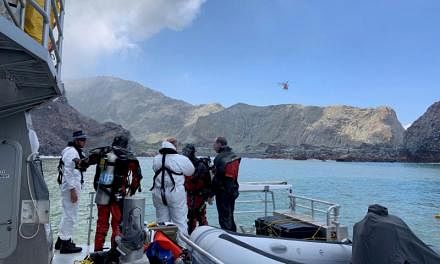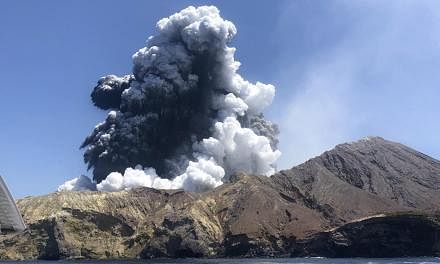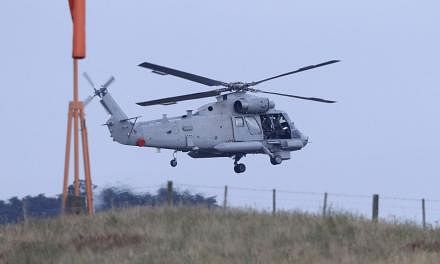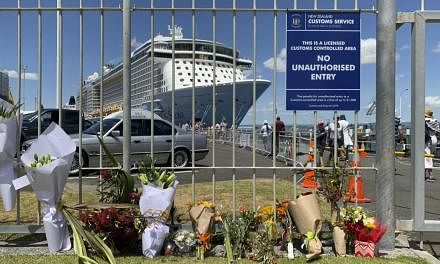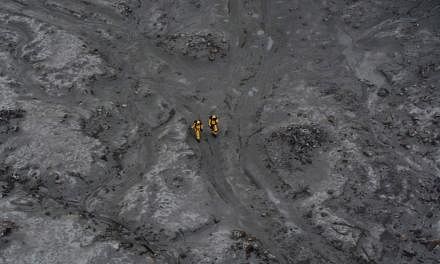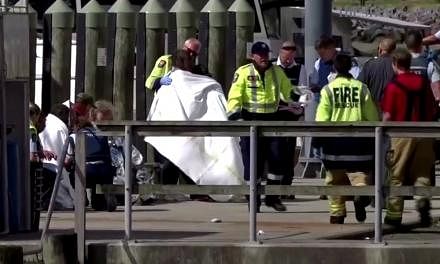WHAKATANE, NEW ZEALAND (NYTIMES, AFP) - They had taken boats to a desolate island to get a glimpse of a natural wonder, but when the White Island volcano erupted on Monday (Dec 9), a scene of stunning beauty suddenly turned into a deadly trap.
At least six people were killed when the volcano erupted on the island off the eastern coast of New Zealand, eight were still missing and 31 remained hospitalised with burns and other injuries.
Three more people had been hospitalised and released.
New Zealand police said on Tuesday the eight people still unaccounted for after the eruption are likely dead.
"I would strongly suggest that there is no one that has survived on the island," New Zealand Deputy Police Commissioner John Tims told reporters in Wellington.
Reconnaissance flights over the area have found no signs of life.
"To those who have lost or are missing family and friends, we share in your unfathomable grief at this moment in time and in your sorrow," Prime Minister Jacinda Ardern said at a news conference in Whakatane, a coastal community near the volcano.
"Our duty," she added, "is to return loved ones."
Police said in a statement that they "commenced an investigation into the circumstances of the deaths and injuries" at the volcano.
However, they backed away from an earlier announcement that the probe was a criminal investigation, saying instead it was being carried out on behalf of the coroner.
Mr Tims said emergency personnel were still trying to gain access to the island but were being held up by the risk of further eruptions and rough wind conditions that had grounded an attempt to get drones above the island for reconnaissance.
"We understand the desire from the locals and the loved ones to remove their family from the island, but we are working round the clock, we are working hard, and we understand what we need to do for friends and family," he said.
The challenge of recovery and the scale of the disaster caused by the volcano - which has been promoted for decades as live and active but relatively safe to visit - played out overnight and into Tuesday morning as officials described dangerous helicopter flights to look for survivors and attempts to treat the wounded.
Among the missing or injured were tourists from Australia, China, Malaysia, the United Kingdom and the United States, along with tour operators from New Zealand.
Prime Minister Scott Morrison of Australia said in a statement that 24 Australians had been on White Island, 13 of whom are hospitalised. As many as three of the five confirmed dead are Australian, as are many of the missing.
On Tuesday morning, relatives gathered at the Port of Tauranga where two large cruise ships sat docked, as officials interviewed people aboard.
On the Ovation of the Seas, a Royal Caribbean ship from which several groups of tourists went to the volcano just before it erupted, no one was being allowed to disembark.
Officials said 47 people were on White Island when it erupted. Dozens more were cruising the area in smaller boats.
"It looked like a nuclear bomb going off," said one witness who spoke to Radio New Zealand.
Others described a slowly emerging cloud of smoke and ash, seen from the water, and the suddenly horrifying realisation that some people were still there.
"This is so hard to believe," said Mr Michael Schade, a visitor from San Francisco, who posted photos and video of his group's departure from White Island moments after the eruption.
"Our whole tour group were literally standing at the edge of the main crater not 30 minutes before."
Twenty-three people, including the five dead, were evacuated on Monday, said Mr Tims.
Among the missing are people who were seen on a webcam exploring the upper reaches of the volcano's crater just before the eruption, Reuters reported.
Ms Ardern said that the tourists on White Island seemed to have had little time to seek shelter before the "very significant" eruption occurred.
The island, also known as Whakaari, is privately owned and is typically visited by thousands of tourists every year, many of them drawn by promotions for "New Zealand's most active volcano".
For Whakatane, a town of about 20,000 that's a hub for White Island tours, the volcano's appeal to visitors is an important part of the local economy.
"The whole tourist industry revolves around the island," said Mr Phil van Dusschoten, a retired police officer who now runs a company that operates dive and fishing trips.
"It's a sombre atmosphere," he said in a telephone interview on Tuesday morning, adding that the smell of sulphur was still wafting in the air.
Mr Van Dusschoten said he was working on his boat when he saw the 12,000 foot-tall ash clouds billowing from White Island. He said he later saw a busload of people, all of whom were shirtless, who had likely been rescued from the island.
"For the last 30 plus years, we've operated without incident, allowing tens of thousands of tourists to visit the volcano," he said. "It's very sad."
On Monday, enveloped in the searing ash, White Island was too dangerous for emergency workers to reach.
Mr Tims told an afternoon news conference there had been no communication with anyone still on the island. Ash and smoke made it difficult for cameras pointed towards the volcano to see anyone on the island.
"We know the urgency to go back to the island," he told reporters.
Ms Ardern travelled on Monday to Whakatane.
"I know that there will be a huge amount of anxiety for those who had loved ones on the island at the time," she said.
Tourists from the Royal Caribbean cruise ship were among those who visited the island on Monday, the company said, but the company did not say how many went or address their fate.
Mr Tims said the police were scheduled to receive a list of those who had gone to the island.
A Royal Caribbean spokesman, Mr Jonathon Fishman, said the company was "working together with local authorities and providing all the help and care we can to our guests and their families, including offering medical resources and counselling".
The eruption was reported to have occurred at 2.11pm local time.
Directly after the eruption, GeoNet, the agency that monitors geological activity in New Zealand, raised its volcanic alert level to four. By about 4.30pm, it was decreased to Level 3, with the agency noting there was no further escalation in volcanic activity.
Police have established a no-fly zone around the island and warned people living near areas that might be affected by falling ash to remain indoors and listen to the radio or television for news updates.
Ash fall can contain jagged particles of abrasive rock or natural glass and anyone exposed to it was advised to wear a dust mask or use a cloth handkerchief to cover their noses and mouths and wear goggles to protect their eyes.
Dr Ken Gledhill, from the research institute GNS Science, likened the eruption to the volcano "clearing its throat" and said that while it looked like it had quietened down, the authorities could not be certain there would not be another eruption within the next 24 hours.
The volcano is New Zealand's most active.
People were allowed to visit the island even after GeoNet had earlier issued bulletins warning of "moderate volcanic unrest" with "substantial gas, steam and mud bursts" observed at the crater lake.

"We've issued two or three bulletins in the last few weeks about the increase in activity," Dr Brad Scott, a GeoNet volcanologist, said in an interview.
He said that even though the volcano has been erupting since 2011, tourists have been undeterred, with visits to the island dating to the late 1800s.
He said the agency passed its information on the volcano's activity to tour operators and police, but tourists make their own decisions about whether to visit the island.
"The weather has traditionally been the only thing that has stopped visitors," he said, noting that the volcano sits in the open ocean and people wanting to reach it have to contend with rough waters to make the journey.
Royal Caribbean Cruises did not say whether it had known of the warnings about the volcanic activity.
The last time there was a large number of fatalities on White Island had nothing to do with a volcanic eruption.
In 1914, part of a crater wall collapsed, causing a landslide and killing 10 men mining sulphur.

